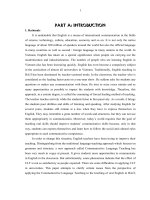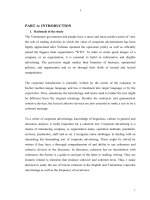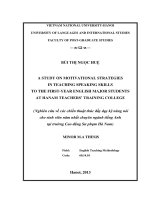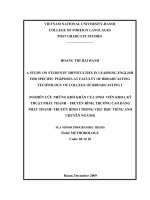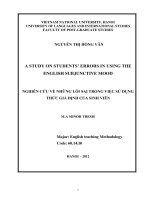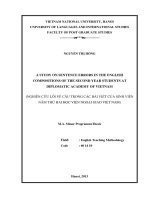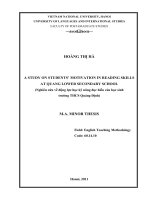A study on students’ errors in using the English subjunctive mood.
Bạn đang xem bản rút gọn của tài liệu. Xem và tải ngay bản đầy đủ của tài liệu tại đây (703.9 KB, 63 trang )
VIETNAM NATIONAL UNIVERSITY, HANOI
UNIVERSITY OF LANGUAGES AND INTERNATIONAL STUDIES
FACULTY OF POST-GRADUATE STUDIES
NGUYỄN THỊ HỒNG VÂN
A STUDY ON STUDENTS’ ERRORS IN USING THE
ENGLISH SUBJUNCTIVE MOOD
NGHIÊN CỨU VỀ NHỮNG LỖI SAI TRONG VIỆC SỬ DỤNG
THỨC GIẢ ĐỊNH CỦA SINH VIÊN
M.A MINOR THESIS
Major: English teaching Methodology
Code: 60.14.10
HANOI – 2012
1
VIETNAM NATIONAL UNIVERSITY, HANOI
UNIVERSITY OF LANGUAGES AND INTERNATIONAL STUDIES
FACULTY OF POST-GRADUATE STUDIES
NGUYỄN THỊ HỒNG VÂN
A STUDY ON STUDENTS’ ERRORS IN USING THE
ENGLISH SUBJUNCTIVE MOOD
NGHIÊN CỨU VỀ NHỮNG LỖI SAI TRONG VIỆC SỬ DỤNG
THỨC GIẢ ĐỊNH CỦA SINH VIÊN
M.A MINOR THESIS
Major: English teaching Methodology
Code: 60.14.10
Supervisor: Dr. DƯƠNG THỊ NỤ
HANOI – 201
2
TABLE OF CONTENTS
TABLE OF CONTENTS................................................................................................iv
LIST OF TABLES..........................................................................................................vi
PART I : INTRODUCTION
1. Rationale ..................................................................................... ...........................1
2. Aims of the study ............................................................................................. ......1
3. Scope of the study .............................................................................................. ...2
4. Methods of the study ........................................................................................... ...2
5. Research Questions .............................................................................................. ..3
6. Design of study............................................................................................................3
PART II : DEVELOPMENT
CHAPTER 1: THEORETICAL BACKGROUND
1.1. An overview of mood..............................................................................................5
1.1.1. Definitions of mood....................................................................................5
1.1.2. Kinds of mood............................................................................................5
1.2. Subjunctive mood...................................................................................................7
1.2.1. Definitions of subjunctive mood................................................................7
1.2.2. Classification of subjunctive mood............................................................7
1.2.2.1 The present subjunctive mood.......................................................7
1.2.2.2 The past subjunctive mood..........................................................10
1.2.2.3 Past perfect subjunctive mood.....................................................14
1.3. Passive forms of subjunctive mood....................................................................16
1.3.1 Use of the present forms of the subjunctive mood....................................16
1.3.2 Use of the past forms of the subjunctive mood.........................................17
1.4. Error analysis and error correction in language learning.............................17
CHAPTER 2: SOME ERRORS MADE BY MAJOR AND NON - MAJOR
STUDENTS IN HAI PHONG PRIVATE UNIVERSITY
i
2.1. The teaching – learning present situation of subjunctive mood..............................19
2.2. Method....................................................................................................................19
2.2.1. Participants...................................................................................................19
2.2.2. Instruments...................................................................................................20
2.2.3. Procedures....................................................................................................20
2.3. Results ....................................................................................................................21
CHAPTER 3: FINDINGS AND RECOMMENDATIONS
3.1. Findings...................................................................................................................25
3.1.1. Recognition of subjunctive mood.............................................................25
3.1.2. The verb forms in the subjunctive mood...................................................29
3.1.2.1. In present form in the subjunctive mood.....................................30
3.1.2.2 In the past and past perfect subjunctive mood.............................32
3.2. Suggested solutions.................................................................................................36
3.2.1. Teachers‟ teaching method........................................................................36
3.2.2. Students‟ learning strategies......................................................................47
PART III: SUMMARY
1. Recapitulation ...........................................................................................................48
2. Conclusions...............................................................................................................48
3. Limitations and suggestions for the further study.....................................................49
REFERENCES...........................................................................................................51
APPENDICES..............................................................................................................I
ii
LIST OF TABLES
Table 1: Typical errors made by English major and non-English major students
Table 2: Errors of using Verb form in the present subjunctive
Table 3: Errors of using Verb form in the past subjunctive
Table 4: Errors made by students in the questionnaires
Table 5:Typical reasons for students‟ errors in survey questions
Table 6: Errors made by students in grammar test
iii
PART I: INTRODUCTION
1. Rationale
There is a variety of spoken languages all over the world, but English
language is the most popular. Billions of people are speaking and using English
everyday in their life. So, English plays an important role in our modern life
because it is one of the vital demands of almost English learners.
However, it is not easy for learners to get success in learning English
because of many difficulties in its grammar, vocabulary and pronunciation…
Grammar is one of the most difficult parts which English learners usually meet
and make errors. In English grammar, mood is a small and special part. Although
mood is not used as much as other parts, for instance: verb tense, sentences or
passive…, it is important for English learners.
People often use Mood in normal dialogues and communication. In the
process of using mood, they rarely use subjunctive mood – one kind of mood. It
is harder to explain the subjunctive. Five hundred years ago, English had a
highly developed subjunctive mood. However, after the fourteenth century,
speakers of English used the subjunctive less frequently. Indeed, the sheer
frequency of subjunctive misuse gives me the impression that the subjunctive
isn‟t taught at all in school, and if it is, those teaching it may not be teaching it
well enough or perhaps few of those they teach get to understand it properly. I
say this basing on the wrong uses of subjunctive mood in written tests by
university students. That makes me try to study more on this aspect with the
hope that my study is useful for every English learner to understand more about
subjunctive mood and avoid making mistakes in using it.
1
2. Aims of the study
The central aims of the study are:
a. Investigating the most common errors which non-English major students at
Hai Phong Private University often make
b. Identifying the main causes of those errors.
c. Reinforcing and enhancing the students‟ subjunctive mood acquisition.
Hopefully, this study can provide readers with overall comprehension of
subjunctive mood. The research results would be really helpful to not only
students but also teachers so they can base on the findings and suggestions to
choose as well as design activities for the lesson in a direction.
3. Scope of study
Regarding to the scope of the study, mood is rather huge and complicated.
Consequently, it requires to be taken into consideration carefully in a very long
time by the researchers. However, due to my limitation of time and knowledge, I
could not cover all the aspects of this theme. This study only concentrates on the
analysis of errors made by first-year non-English majors and the errors are just
restricted to the ones related to subjunctive mood.
4. Methods of study
This is a survey research which was carried out by means of such data
collection instruments as questionnaires and interviews for students and the
students‟ writing papers. Each of them is conducted with its own direction.
First, the interviews were done among twenty first year non-English
majors and English Majors at Hai Phong Private University with the questions
related to the thesis topic. The second study method is to analyze the writing
papers of students coming from two groups English majors and non-English
2
majors with the aim of recognizing as well as classifying the errors exactly. The
second method is considered as more effective one.
5. Research questions
The study aims to answer the two following questions:
1. What are the typical errors that the first-year English majors and nonEnglish majors often make during their study at Hai Phong Private University?
2. What are the suggested solutions to those typical errors ?
6. Design of the study
The study is divided into three main parts; of which the second, naturally,
is the most important part.
Part one presents an overview of the study in which the rationale for the
research, the research problem, the purposes, the research questions, the scope of
the study, the research method, as well as the design of the study were briefly
presented.
Part two with three main chapters:
Chapter one reviews the literature relevant to the study, including the
definition of mood, as well as an overview on subjunctive mood. These lay the
foundation for the choice of the medium for the research. More specifically, it
presents a number of research in which subjunctive mood has been used to help
students make improvement in their language study.
Chapter two is a detailed discussion of the method used in the study. This
chapter presents a thorough justification for the use of subjunctive mood and
survey research. It also gives a thorough description of the research‟s
components, as well as the research program.
3
Chapter three discusses the findings of the study, provides pedagogical
implications, as well as presents limitations of the research. It also makes
recommendations for further research in the same field.
Part three summarizes the main issues of the whole study with a
conclusion ending the study and supply some suggestions for further study.
4
PART II: DEVELOPMENT
CHAPTER 1: THEORETICAL BACKGROUND OF SUBJUNCTIVE
MOOD
As the subjunctive mood will be analysed in detail in chapter two, this
part will deal with not only general view on mood but also particular
explanations and concepts related to subjunctive mood. It will provide you a
closer look at its definition, formation, usage and its problems in present day
English. Besides, the definitions of errors and correction are also given to make
clearer about the aims of this research. These below knowledge had been
collected from many believable resources and websites such as www.
usingenglish. com, www. yourdictionary. com , tailieu. vn, Azar - Understanding
and using English Grammar....
1.1. An overview of mood
1.1.1. Definitions of mood
In grammar, Mood is category that reflects the speaker‟s view of an
event‟s reality, likelihood or urgency. There are some definitions of mood :
- Mood shows the attitude of the speaker or the writer to the action or state
described by the verb.
- Mood is a characteristic of verbs that involves the speaker‟s attitude
toward the action expressed.
- Mood of a verb expressing wishes, stipulating demands, or making
statements contrary to fact…
1.1.2. Kinds of mood
In English, mood is classified into three types, namely, indicative mood,
imperative mood and subjunctive mood.
5
1.1.2.1. The indicative mood
The indicative mood is the use of verb in ordinary statements and pose
question. It is regarded as a factual or neutral situations, as something which has
occurred or is occurring at the moment of speaking or will occur in the future.It
may denote actions with different time-reference and different characteristics.
Therefore the Indicative Mood has a wide variety of tense and aspect forms in
the active and passive voice. The indicative mood has three forms: the
affirmative, the negative, and the interrogative.
E.g. - She went home late yesterday.
- Has he called her yet?
1.1.2.2. The imperative mood
The imperative mood expresses a command or a request to perform an
action addressed to somebody, but not the action itself. As it does not actually
denote a specific action it has no tense category; the action always refers to the
future. The imperative mood is used only in imperative sentences and cannot be
used in questions. The imperative mood is used to give orders and instructions.
E.g. - Go home!
- Come and see me!
Notice that there is no subject in these imperative sentences. The pronoun
you (singular or plural, depending on context) is the "understood subject" in
imperative sentences. Virtually all imperative sentences, then have a second
person (singular or plural) subject.
1.1.2.3. The subjunctive mood
The subjunctive mood shows that the action or state expressed by the verb
is presented as doubts, possibility, wishes, desire or anything else contrary to
6
fact. The subjunctive mood has synthetic and analytical attitude of the speaker to
real fact. It is not used much on English any longer and can be found in a few
phrases.
E.g. - I wish I were ten years younger.
- If you taught me, I would learn quickly.
1.2. Subjunctive mood
1.2.1. Definitions of subjunctive mood
In many reference books or websites, the definitions of subjunctive mood
have the same meaning. These are some definitions of subjunctive mood:
The Subjunctive Mood is used not to indicate that something is being
asserted but that it is contrary to fact, supposed, doubted, feared or desired.
The Subjunctive Mood is the mood of a verb used to show hopes, doubts,
wishes….
The subjunctive mood is used more in writing than in speech. It is not
used very much in modern British English. “The old subjunctive is disappearing
as language usage becomes modified and simplified. Current business usage
recognizes it only as a wish mood" (Dumond, 1993)
1.2.2. Types of subjunctive mood
The subjunctive mood is divided in three types. They are present
subjunctive mood, past subjunctive mood and past perfect subjunctive mood.
1.2.2.1. The present subjunctive mood
In the present subjunctive mood, the verb to be has the form be for all the
persons-singular and plural, which differs from the corresponding forms of the
indicative mood (the present indefinite). Sentences in which normally have used
the verbs: “is”, “are”, “was”, “were” or “will be” should have the root word “be”
7
if they are used in the present subjunctive mood.
In all other verbs, the forms of the present subjunctive mood differ from
the corresponding forms of the indicative mood only in the third
person
singular, which in the present subjunctive has no ending “–s”.
E.g. - The Queen lives here. (simple present tense)
- Long live the queen! (present subjunctive)
The present subjunctive denotes an action referring to the present or
future. This form is but seldom used in Modern English. It may be found in
poetry, in scientific language and in the language of official documents, where it
is a living form.
There are four ways in which sentences are formed in the present
subjunctive mood:
a. Express a wish, a prayer, a hope or a cause in certain fixed phrases
These expressions are fixed. There is no change in every part in the
phrase. So, the verbs in the fixed expressions are not put. I think the learners
should remember and learn by heart their meaning and usage.
E.g. - Long live the Queen!
- God save the motherland!
A wish can also be expressed by “may + infinitive” (in the present) and
“might + infinitive” (in the past):
E.g. - May you be happy all your life.
- They prayed that she might soon be well again.
b. In object clauses
It formed as the object a verb indicating a desire, intension, request,
resolution, command, recommendation…
8
In object clause after verbs and word-groups, it expresses a will, or a wish
for the future, or a desire, intention…Some verbs are normally used in this case:
advise, ask,command,demand,desire,insist,propose,recommend,request +(that)...
The present subjunctive mood looks like the infinitive form of the verb,
and all persons (including the third person singular) are written or spoken
without an “s” in affirmative form and with only “not” in negative form. It takes
the same form whether we are referring to the present, the past or the future.
E.g. - She urged that he write and accept the post.
- We recommend that they not build this company near our resident.
The present subjunctive is also used in object clauses after impersonal
expressions with the same meaning as the above verbs: It + be + [desirable/
essential/ important...] + that + present subjunctive clause.
In fact, we commonly avoid using the subjunctive mood (especially in
British English). The present subjunctive mood is often replaced by using the
structure: should + infinitive.
E.g. - It is our wish that he should do what he pleases.
- It is necessary that we should go home early.
c. In some adverbial clauses
Adverbial clauses of concession are introduced by the conjunctions and
connectives: “though, although, however, no matter, whatever, whoever …”.The
analytical subjunctive with the mood auxiliary may (might) is generally used.
E.g. - Though the whole world condemns him, I will still believe in him.
- Whatever obstacles may arise, we shall not give in.
When a clause of purpose is introduced by the conjunctions “that, as, so
that, in order that…”, we find the analytical subjunctive with the mood auxiliary
9
may/might if the principal clause refers to the present or future; if the principal
clause refers to the past, only the form might is used.
E.g. - She opens the window that she may get a breath of fresh air.
- He got up, cautiously, so that he might not wake the sleeping boy.
d. In inversion of first conditional sentences
Adverbial clauses of first condition containing the verbs could/should in
the If clause are often introduced without any conjunction. It denotes an unsure
fact.
E.g. - Should he come this way, I will speak to him.
- Should you see Tom, tell him to come to my office.
1.2.2.2
The past subjunctive mood
We have been taught the normal conjugation of the verb “to be” in the past
tense as “I was”,“he was”,“they were”,“you were”… But in the past subjunctive
mood, the verb to be has the form were for all the persons singular and plural,
which in the singular differs from the corresponding form of the indicative mood
(the past indicative). When the verb is different from be, it has the form the past
indefinite of Indicative mood (V-ed). The subordinate clause, if any, in such
sentences must also be expressed with verb in the past tenses.
It does not necessarily express a past action. In adverbial clauses of
condition, it denotes an unreal condition referring to the present or future. In
other types of subordinate clauses, it denotes an action simultaneous with the
action expressed in the principal clause; thus, it may refer to the present and to
the past. The past subjunctive mood is used in the following circumstances:
10
a. In conditional clauses implying a negative or in clauses in which the
condition is combined with reality
In second conditional sentences, it expresses an unreal condition (in the
subordinate clause) and an unreal consequence (in the principal clause).
In sentences of unreal condition referring to the present or future, the past
of the verb to be is used in the subordinate clause; with other verbs, the same
meaning is expressed by the past indefinite of the indicative mood. In the
principal clause, we find the analytical subjunctive consisting of the mood
auxiliary should or would and the indefinite infinitive. Should is used with the
first person singular and plural, would is used with the second and third persons
singular and plural.
E.g. - If I were you, I should accept the offer.
- What would you say if I asked you to join us for a holiday.
In mixed conditional type, it refers to no particular time and the
consequence to the past. It has the form:
[If simple past tense, S + would have + PII].
E.g.
- If he were a good student, he would have studied for the exam yesterday.
In inversion of second conditional sentences, adverbial clauses of second
condition containing were in subordinate clause is often introduced without any
conjunction. It refers to a difficult fact.
E.g.
- Were I once again among the heather in those hills, I should be myself.
b. The conjunctions introducing adverbial clauses of condition are: if, in
case, provided, suppose, and some others
* In case and Provided/Providing are chiefly used in sentences of real condition.
E.g. - In case I do not find her at home, I shall leave her a note.
11
- Providing, you drive carefully, I will lend you my car.
* Suppose/Supposing is more common in sentences of unreal condition.
E.g. - Suppose you were in that haunted house, what should you do?
- Supposing I had a day off yesterday, I would go to Do Son Beach.
c. In object clauses when the predicate of the principal clause is expressed
by “wish”/ “If only”
It refers to an unreal fact. If the action expressed in the object clause is
simultaneous with that of the principal clause, the past subjunctive of the verb to
be is used. The form [S + wish/wished + (that) + past subjunctive clause]
expresses a regret or a wish about a present situation.
E.g.
- I wish I were the Prime Minister of India for a year.
- I wish my brother were here now so that he could teach me algebra.
* “Wish” can be put into the past without changing the kind of subjunctive.
E.g. - He wished he knew her address.
- I wished you could drive the car.
* “If only” can be used in the same way. It has the same meaning as wish but is
more dramatic.
E.g.
- If only he did not smoke!
- If only she were the beauty queen now.
d. In adverbial clauses of comparison (or manner) introduced by the
conjunctions as if /as though
The past subjunctive can be used after as if/ as though to indicate unreality
or improbability or doubt in the present. There is no different meaning between
12
as if and as though. If the action of the subordinate clause is simultaneous with
that of the principal clause the past subjunctive of the verb to be is used; with
other verbs the same meaning is expressed by the past indefinite of the indicative
mood. It has form: [S + verb + as if/ as though + past subjunctive clause]
E.g. - George tries to order me about as if I were his wife.
- Do you notice Robert walking as though he were drunk?
However the past subjunctive mood is not used in predicative clauses
introduced by the conjunctions as if/as though when we find the linking verbs to
be, to feel, to look, to seem, to sound….in the principal clause.
e. In attributive clauses modifying the noun time in the principal clause “It
is time” or “It is high time”
It indicates that it is already late for taking the indicated action. High is
added to emphasize this idea. In this case, the past subjunctive of the verb to be
is used; with other verbs the same meaning is expressed by the Past Indefinite of
the indicative mood. It has form: [It is time + past subjunctive clause].
E.g.
- The match will commence at 10o‟clock and it is time you got ready.
Besides, in these following cases, there is a slight difference in meaning
between the forms: [It is time + infinitive] merely states that the correct time
has arrived; [It is time + past subjunctive mood clause] implies that it is a little
late and the speaker complains about something should be done.
E.g.
- It is already half past midnight, and it is time we returned home.
- It is time for us to go home on time.
f. Sentences staring with “would rather” indicate one’s preferences
Sometimes would sooner can be used instead of would rather. There is no
13
difference of meaning between them. When the subject of would rather/ would
sooner is the same, the past subjunctive mood is not used. It is followed by the
bare infinitive. It has the form: [S + would rather + (not) bare infinitive].
E.g. - I would rather go to a movie tonight than study grammar.
When the subjects of would rather are different, we use the past
subjunctive mood after would rather to express the present contrary to fact.
E.g. - Henry would rather that Jane worked in the same department as he does
(but Jane doesn’t work in the same department).
1.2.2.3. Past perfect subjunctive mood
The verb to be in the past perfect subjunctive mood has form had been for
all persons singular and plural. When the V is different from be, it has the form
the past perfect indefinite of indicative mood (had + PII). The subordinate
clause, if any, in such sentences must also be expressed with verb in the past
perfect tenses.
The past perfect subjunctive expresses the unreal past event. It can be
considered the past form of the past subjunctive mood which was explained in
the previous subsection. It is certain that the event was not occurred. It often cooccur with if clause.
a. In the third condition
In sentences of unreal condition referring to the past perfect of the
indicative mood is used in the subordinate clauses; in the principal clause we
find the analytical subjunctive consisting of the mood auxiliary should (with the
first person) or would (with the second person) and the perfect infinitive. It has
form:
[If past perfect tense, S + should/would + have PII]
14
E.g. - If I had known you were in hospital, I would have visited you.
The past perfect subjunctive mood is also used in mixed type of sentence
of unreal condition referring to the past and the consequence referring to the
present or the future. It has form:
[If past perfect tense, S + should/ would + bare infinitive]
E.g.
- The plane I intended to catch crashed and everyone was killed. If I had
caught that plane, I would be dead now.
b. The past perfect subjunctive mood expresses an unreal fact or unreal
event in the past
It can be considered that past form of the past subjunctive mood. It is used
in adverbial clauses of concession with conjunctions and connectives: though,
although, however, no matter, whatever, whoever…
The analytical subjunctive with the mood auxiliary may/might. The action
of the subordinate clause is prior to that of the principal clause, the perfect
infinitive (may have + PII) is generally used.
E.g. - However badly he may have behaved to you, he is still your father.
It is also used in adverbial of comparison (or manner) introduced by the
conjunctions as if/ as though to indicate the action in the past. If the action of the
subordinate clause is prior to that of the principal clause, the past perfect (had +
PII) of the indicative mood is used.
E.g.
- She spoke about him as if she had known him for many years.
In object clauses, the past perfect subjunctive is used when the predicate
of the principal clause is expressed by “wish”/“If only”. It refers to an unreal
past. If the action expressed in the object clause is prior to that of the principal
15
clause, the past perfect of the Indicative mood (had + PII) is used.
E.g. - I wish John had come on time.
- If only my friend had learned by heart the lesson.
1.3. Passive forms of subjunctive mood
The passive voice tenses discussed so far have all been in the Indicative
mood. However, verbs in the passive voice can also be put into the subjunctive
mood. It has been seen that all of the tenses in the passive voice are formed using
auxiliaries. As has already been explained, the subjunctive mood of tenses using
auxiliaries is formed by putting the first auxiliary into the subjunctive mood.
The normal form passive subjunctive: [Auxiliary + Past Participle]
The following table summarizes the formation of the subjunctive tenses of
the passive voice:
The formation of the subjunctive mood of the passive voice
Tense
Auxiliary
Verb Form
Simple Present
be
past participle
Present Continuous
be being
past participle
Present Perfect
have been
past participle
Present Perfect Continuous
have been being
past participle
Simple Past
were
past participle
Past Continuous
were being
past participle
Past Perfect
had been
past participle
Past Perfect Continuous
had been being
past participle
1.3.1. Use of the present forms of the subjunctive mood
Like the present subjunctive of the active voice, the present subjunctive of
the passive voice is often used in subordinate clause beginning with that in
16
sentences which contain formal commands, or requests. As can be seen from the
table above, the present subjunctive of the passive voice is formed from the
invariable auxiliary be, followed by the past participle of the verb. The following
sentences are examples of the use of the present subjunctive of the passive voice.
E.g. - We asked that our suggestions be considered.
- They will insist that their colleague be admitted to the association.
1.3.2. Use of the past forms of the subjunctive mood
Like the past forms of the subjunctive of the active voice, the past forms
of the subjunctive of the passive voice are used in wishes, and in statements
containing false or improbable conditions.
E.g. - I wish he were allowed to come.
- It would have been better if they had been invited.
In the first example, the past subjunctive of the passive voice is used in
expressing a wish. In the second example, the Past Perfect subjunctive of the
passive voice is used in expressing the false condition.
The past subjunctive mood of the Passive Voice has the form of the past
tense of the passive voice “were/was + PII” but in the past subjunctive, the form
“was” is not used, we just only use the form “were” for all persons.
And the past perfect subjunctive mood of the passive voice has the form of
the past perfect tense of the passive voice: [S + had been + Past participle]. It
indicates the unreal event in the past or false condition.
1.4. Error analysis and error correction
According to Dictionary of Language Teaching and Applied Linguistics
(1992) a learner makes a mistake when writing or speaking because of lack of
attention, fatigue, carelessness, or some other aspects of performance. Mistakes
17
can be self-corrected when attention is called. Whereas, an error is the use of
linguistic item in a way that a fluent or native speaker of the language regards it
as showing faulty or incomplete learning. In other words, it occurs because the
learner does not know what is correct, and thus it cannot be self-corrected.
It is inevitable that learners make errors in the process of foreign language
learning. However, what is questioned by language teachers is why students go
on making the same errors even when such errors have been repeatedly pointed
out to them. Yet not all mistakes are the same; sometimes they seem to be deeply
ingrained, but at other times, students correct themselves with ease. Thus, we –
language teachers - came to realize that the errors a person made in the process
of constructing a new system of language is needed to be analyzed carefully.
Error analysis will give benefits in three ways: (1) language errors made by the
learners can be a good input for teachers on how far the learners get progress and
what areas need to be improved. (2) the errors can be an evidence for us on how
to learn a language and what kind of strategy to learn it. (3) the errors found out
can be used as feedback for the learners. After finding out the language errors
made by the learners, we need to think about what to do next to overcome the
problems. Error correction is as important as identification and description of
them.
Error analysis and error correction will be the two main tasks through this
study on errors of subjunctive mood made by English majors and non-English
majors in Hai Phong Private University .
18
CHAPTER 2: SOME ERRORS OF SUBJUNCTIVE MOOD MADE BY
NON-MAJOR STUDENTS IN HAI PHONG PRIVATE UNIVERSITY
2.1. The current situation of subjunctive mood teaching and learning for
students in universities
Curricula for non-English majors require that subjunctive mood teaching
should be arranged as part of the program. As one of the required parts,
subjunctive has been taught to English majors in universities and colleges for
years. It is known that “One of the most confusing aspects of English for the
learners”. Especially, the English subjunctive, involving a backshifting of tense
and mood, are challenging for Vietnamese learners.
Guaranteeing the accuracy of the sentences mainly depends on the
learner‟s mastery of grammar. Subjunctive mood, which is sometimes an
indispensable part of a language, is so important that the teachers and students
have always attached great importance to subjunctive mood teaching and
learning. For the above - mentioned reasons, how to make subjunctive mood
teaching and learning effective and efficient is an important task for both
English teachers and researchers. To find out those things, we must start from the
errors which are made by learners, then have suitable solutions for those
situations.
2.2. Method
2.2.1. Participants
One first year university English major class and one non-major English
class of Hai Phong private university participated in the current study. All
participants (N =90) were native speakers of Vietnamese. Those intermediate
level learners had had instructions on the subjunctive. Thus, these learners
19
appear to have been at a similar instructional stage. Although no claims can be
made about the subjunctive instruction participants had received in high school,
in this university language program, subjunctive instruction begins as early as
the second semester. In this course, participants had already been instructed on
the subjunctive in evaluative statements, adverbial clauses, adjectival clauses
and noun clauses of desire and influence and on the imperfect subjunctive in „if‟
clauses.... Forty were female and sixty were male and their undergraduate
majors included business, social, sciences. Their ages ranged from 18 to 22
years, with an average age of 19.1 years.
2.2.2. Instruments
The materials for this study are divided into two parts:
1) Questionnaire of grammar theory: The questionnaires included fifteen
sentences in the forms of multiple choice question consisting of three option
(A,B,C) but just one of them is right. All of these questions are involved in
grammatical constituents needed to be identified. The participants must complete
grammaticality judgment task in which they have to provide correct grammar
theory
2) A test of grammatical competence in the subjunctive, which is divided into
four different exercises: I) Underline the correct parts + II) Choose the best
answers + III) Fill into the blank + IV) Complete the sentences.
2.2.3. Procedures
After getting permission from the Head of Foreign Language Department
and the main lecturers, the researcher visited those two classes personally and
asked for volunteers to complete the test during class time. Students were told
that the aim of the study was to find out some usual errors the students made and
20
